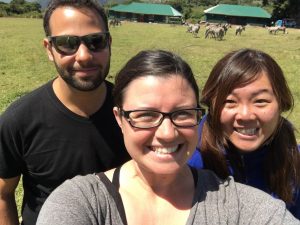
GoodBye Addis



This week was a whirlwind.
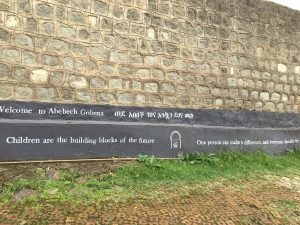
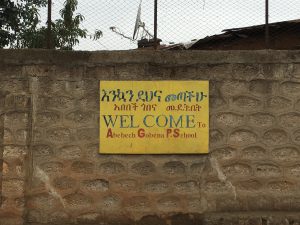



This week we were fortunate enough to have the opportunity to be a part of the Special Needs Program at KokeTsiba Primary School. My experience as an SEA prepared me for what we were going to see and experience. I went into the school with slight trepidation. I was unsure what exactly we were going to encounter. Would the student’s needs be being met? Would there be an overwhelming amount of students with not enough support? How would the physical space be organized? What was I going to walk into?
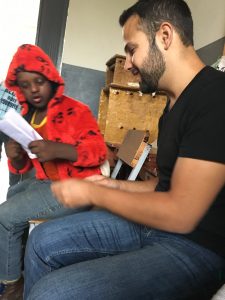
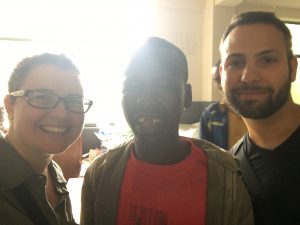 When we arrived the students were taking part in physical activity on the school field. We were shown the various empty classrooms and then invited to observe the students on the field. We sat down on the cement bleachers and the first I noticed were the smiles and looks of joy on each student’s face. They were all on the field playing various team and individual games. Some were distracted by our presence but after a quick wave and hello, they went right back to their activities. As we were sitting there a couple of students came and went. And each time they passed us by they would greet us with a handshake and ‘Hello, how are you?’. One non-verbal girl passed Leanne and myself and then stopped in front of Grant. She looked him in the eyes and then rubbed her hands on his cheeks, feeling his beard. Before walking on she gave him a little hug and a smirk. Once PE was over all the students passed us by on their way back to class. One by one they shook our hands and said hello. The teachers were present but all of the students were making their way back to class unassisted.
When we arrived the students were taking part in physical activity on the school field. We were shown the various empty classrooms and then invited to observe the students on the field. We sat down on the cement bleachers and the first I noticed were the smiles and looks of joy on each student’s face. They were all on the field playing various team and individual games. Some were distracted by our presence but after a quick wave and hello, they went right back to their activities. As we were sitting there a couple of students came and went. And each time they passed us by they would greet us with a handshake and ‘Hello, how are you?’. One non-verbal girl passed Leanne and myself and then stopped in front of Grant. She looked him in the eyes and then rubbed her hands on his cheeks, feeling his beard. Before walking on she gave him a little hug and a smirk. Once PE was over all the students passed us by on their way back to class. One by one they shook our hands and said hello. The teachers were present but all of the students were making their way back to class unassisted.

The students were of varying needs, both physical and developmental. They were divided into 4 different classes, A, B, C, & D: A was for the more capable students, B for students who required a little more support, C for new students entering the program and students with severe needs, D was vocational studies. We had the opportunity to sit in on A class. We sat among the students at the back of the room. The students were focusing on parts of the body in English. It was an interactive lesson where the students would show a part of the body and what its function was. They also worked on math; adding and subtracting one digit numbers. The teacher had a way with the students. It’s hard to describe but the class was calm and all of the students were very responsive to what was happening. The older students would instruct the younger students when they were acting out. The class all worked together to maintain the level of calm and to teach one another. All of the students wanted to participate and even the non-verbal students were engaged and participating. The students were learning from not only the teacher but the other students in the room.
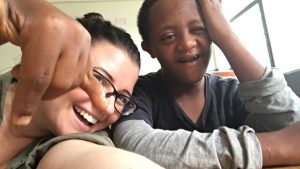
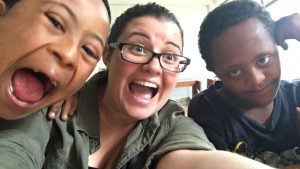
On Thursday we had the opportunity to head to a rural community 80km outside of Addis. Although the drive was long, there was so much to see along the way. Before we left we had talked with friends about where we were going and what we wanted to see. We had mentioned wanting to see different animals but we had already seen so many in the city that we didn’t think we would see anything new. They quickly informed us that oh there is a difference – there are city donkey and country donkey. We would know the difference.
We traveled with two representatives from CODE Ethiopia. We went to a community library and a secondary school. The CODE representatives wanted to investigate how the libraries were running and what the students thought of the materials that were present. They asked the students many questions around what kind of books they like to read, what they don’t like to read, if they could have any book what would it be, what subject areas they like reading about. Many of the student’s responses centred around textbooks and reading in preparation for exams. In the Ethiopian culture they do not have a lot of time to sit and read. Their tradition is an oral history. Because of this, many adults have passed onto their children the importance of oral history but not the written word. It was interesting to know that many of the students only read the material that is going to further their education, not books for pleasure. One question that I had difficulty with was when the CODE representative asked if the students preferred o read in English or their native tongue. For me, the answer was quite simple. Of course the students would rather read in their native tongue. The stories would hold more meaning for them and they wouldn’t be work. While many of the students are fluent in English, it is much different to speak and write in English than it is to read a novel for pleasure. It was also interesting to note that the students were not able to check the books out. If they wanted to read a book they had to sit in the library to do so. I believe that would be another barrier to students reading for pleasure. It is difficult to read a whole novel in one sitting and how are they to know if that book is going to be available the next time they come into the library? Overall, it was an interesting day. I learned a lot about the number of diverse communities and cultures that make up Ethiopia and that being attuned to students diverse backgrounds enables us to better facilitate their learning.
The journey with the CODE ladies also helped me to appreciate more where we are staying and our willingness to take risks. We have taken to saying “Whatever happens, happens – we are in Ethiopia!” We have been willing to get out of our comfort zone and try new things, which has made this trip more of an adventure and enabled us to see more of what Ethiopia has to offer.
On Friday we had the opportunity to take one of the teachers from KokeTsiba out for lunch. He mentioned the phrase “Sharing is happiness” and I believe that it sums up the the Ethiopian culture. Everyone is very open and friendly. They are quick to offer you a helping hand or a friendly conversation. Meals are also a time of sharing. We have found that Ethiopian meals are never a quick bite. Lunch usually lasts a few hours and you order a big plate to share. You always feel welcome in Ethiopia and we have made some lasting friendships so far in our two short weeks.
We have explored and learned so much in our first week in Addis Ababa, Ethiopia.
We arrived not really knowing what to expect. After a 23 hour adventure we finally stepped foot on Ethiopian soil. We were greeted with warm weather and excitement from our contact/guide/new friend Hareg and her husband. We had booked in to stay at the SIM Guesthouse but did not know much about it, not even where it was exactly located. Our first lesson: Addresses in Ethiopia are nothing like addresses in North America. They rely on landmarks and do not have many street signs. We took the first day to catch up on sleep and adjust to the 10 hour time difference. On Sunday we walked around the city, got lost a couple of times, got caught in a rain storm, and wore ourselves out!
Monday morning we met Hareg at Addis Ababa University. As we were still unfamiliar with the area, she graciously sent a card to pick us up. We spent the day meeting some of the faculty of Education and Behavioural Studies Department, including the Dean and Associate Dean. It was great getting to finally put a face to the names we have been emailing over the past few months. We then travelled to our first primary school. The setting was much different from the primary schools we are used to. This week in Ethiopia, some schools are holding government examinations and the students who were not writing exams did not have to attend classes. The first school we visited was an examination centre so there were not many student around. Later in the day Hareg introduced us to traditional Ethiopian food and we of course ate too much! It was delicious. The day went by so fast.
For the rest of the week we were able to observe and teach classes at Beherawi Bete Mengist Primary School. We were fortunate enough to have the opportunity to first observe a few different classes and then introduce the students to Canada and parts of our culture. The students were amazing. As soon as a teacher walks in the room they all stand and say “Hello teacher”. The teacher will greet them and ask them to have a seat – in unison they say “Thank you teacher” and silently sit down. I was in awe of the level of respect the students showed to their teachers. No students were talking out of turn and when the teacher had their back to them, they silently waited.
When it was our turn to teach, we excitedly asked ‘Has anyone heard of Canada?’ None of the students had. We took this opportunity to showcase where we live and some of the similarities and differences between British Columbia and Addis Ababa.
Overall, this week has been a very humbling experience. I can’t quite explain the rush of feelings that I had over the course of this week but I know that I am no where near ready to come home. I am looking forward to the coming weeks and getting to explore, observe, and hopefully teach in the other local primary schools.
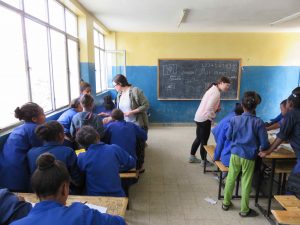
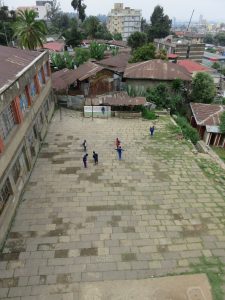
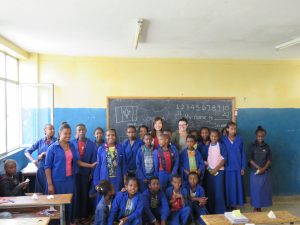
Plickers are a great tool for formative assessment. Not only do they engage my students in learning, my students think it is a super fun game! I was frequently asked:
“Can we use those weird card things? You know, that we turn to answer questions and they have our numbers on them?”
I was able to use Plickers to assess my student’s understanding of different subject areas. A great feature is that you do not have to display student responses. While using Plickers, I turned off the display responses option but left the display of who had answered. My students thought this was a game, “Ms. Wynne, you missed R!” The students were very instrumental in making sure that I was able to record everyone’s response. No student felt as though they were on the spot though because it was Ms. Wynne who was not panning properly or too quickly. It also gave students who were not comfortable sharing, the opportunity to participate. I found that when asked a question, many of my students would look to one another for the answers. Using Plickers, encouraged students to think for themselves and gave me a better understanding of where they were at, as opposed to finding out how well they are able to peek at their neighbour’s response.
I also like that you, the teacher, are able to create the questions that you want to display. This allows teachers the ability to ask varied questions and tailor the questions to your particular students; a great personalized learning tool. I also found that throwing in a couple of ‘easy’ or ‘fun’ questions at the beginning and throughout engaged my students, kept them engaged, and encouraged them to answer all of the questions.
The only downfall to Plickers is the set up. It was more of a game for my students and elicited a lot of excitement, which I welcomed. But, I think with continued use and introducing them early in the year would make it more routine and enhance the assessment possibilities.
It is rare that I am able to find a story that engages every single one of my students at the same time, I’ve tried. But I have found that using a visual representation of the same story captures all of their attention. Whether it is listening to the audio of someone else reading the story, watching it acted out, or having it come to life, all of my students are engaged!
Because of this, I have been looking for resources that allow my students to watch a story rather than listen to me. I have been utilizing animation videos from “YouTube” and other video websites. I have found that many of the videos are age appropriate and offer my students a different example of what is a ‘story’. I have not stopped reading to my students though! And I don’t think I ever will. It is just as important to read to the students as well as offer them an alternative in watching a story.
Words of advice: watch the video all the way through. I have watched a few videos that I thought would be perfect, but the ending is inappropriate. It is also good practice to know what you are showing your students before you show them.
I have the fortunate opportunity to be a part of a school community that has many technology resources. In my classroom, I have a document camera, a projector, a laptop, a desktop computer, speakers, and 6 iPads that ‘belong’ to my class. I also have the option of signing out a class set of iPad minis.
I have tried to integrate technology into my practice by using it to enhance my lessons, as well as allow students to use it for research. Before I ask my students to use a certain website or look something up, I first research and find which websites are suitable and factual. As my inquiry project progressed, I found information that suggested that we, as teachers, must first familiarize ourselves with the technology and resources we want our students to interact with. I have found this to be very true while on my practicum. But I have also come to realize that the students themselves are a huge resource! They have had the opportunity to explore with various modes of technology, and as such, are well versed. If I am teaching myself how to use a new form of technology, I ask the students if they have ever used it or tried it. They love to teach me new things and how things work. I have also found that even if I do know how something works, asking my students to show me allows me to see how much they know and where I should begin my instructions.
For one of my lessons, I had initially devoted a whole block of time to showing my students how to use book creator. That was until I discovered that many of them are pros when it comes to book creator. Instead, I was able to focus my lesson on what the subject matter and I had an extra block of time to use to my advantage!
One area where I will always do my homework before allowing students to engage with technology is when I ask the students to research a certain topic. You can type a single word into google and it shows you thousands of websites that offer snippets of the information you are looking for. A lot of this information is great, but there is also a lot that is not appropriate for students. Because of this, I have made sure to do the research myself and ask students to use specific websites, rather than just let them browse the thousands of links that google provides!
How can technology be used as both an assessment tool and a student resource to personalize learning?
Where I came from: I knew that I wanted to incorporate technology into my practice, I wanted to use technology to both enhance my teaching as well as use it as an assessment tool. I was eager to see how technology was being utilized in todays classrooms. My practicum classroom has access to a number of technology resources with in the classroom and wider school community, including: iPads, laptops, iMacs, and a number of tech tools. I noticed that technology was being used as both an assessment tool as well as a tool for facilitating brain breaks. I was interested in how to facilitate technology for both my assessment as well as student learning.
Where am I now: I am working to integrate technology into both my unit and lesson plans. Yet, I am being mindful to focus on both the content and curriculum and then taking the opportunity to integrate technology. Fabrikant et al suggest that it is important for us to know what we are doing before we expect our students to know. We should familiarize ourselves with the information and the use of technology before we require our students to use it within the classroom. Using technology is not about having another teacher in the classroom, but using it to enhance our lessons and better equip students. I have also been influenced by Monica Burns writing, which is featured on Edutopia. With the help of Vicki Davis, also featured on Edutopia, I have begun to develop my own ‘toolkit’ of technology resources. Developing a ‘toolkit’ is a personal process; it is a set of tools which are personalized to the needs of both your class and yourself. The article ‘No Teacher is an Island: How Social Networks Shape Teacher Quality’ opened my eyes to the importance of establishing a strong social network, working with other teachers and professionals. The importance of these networks is to learn from one another; to learn from and teach others the tools that I have been able to utilize within my classroom and they have been working with. It also strengths our ability to use these tools as we are teaching and learning from other professionals before attempting to use them within our own classrooms or with our own students.
Where am I headed: Throughout my inquiry I have come to recognize and appreciate the need for media literacy. As our world progresses we constantly have access to technology and the various facets of technology – yet, many students do not yet have the skills to utilize this technology or become an active participant in a social network. I would like to continue to research ideas on how to effectively introduce students to media literacy, as well as what it means to be an active member of social networks. I would like to work not only with students, but also with parents to establish their presence on the class Freshgrade account. As we are utilizing Freshgrade as an assessment tool, it is important that both parents and student know how to make meaningful and constructive comments on displays of student work.
Works Cited
Baker-Doyle, K. (2015). No teacher is an island: how social networks shape teacher quality. Promoting and Sustaining a Quality Teacher Workforce, 367-383. Retrieved from: https://www.academia.edu/19709903/No_Teacher_is_an_Island_How_Social_Networks_Shape_Teacher_Quality
Burns, Monica (2015). Empowering teachers with tech-friendly formative assessment tools. Retrieved from: http://www.edutopia.org/blog/tech-friendly-formative-assessment-tools-monica-burns
Davis, Vicki (2014). The epic BYOD toolchest (51 tools you can use now). Retrieved from: http://www.edutopia.org/blog/the-epic-byod-toolchest-vicki-davis
Fabrikant, K., York, S., Morris, M. Integrating technology into pedagogical content knowledge in K-12 and university professional development. Building Sustainable Futures for Adult Learners, 541-558. Retrieved from: https://www.academia.edu/21070374/Integrating_technology_into_pedagogical_content_knowledge_in_K-12_and_university_professional_development
This past Thursday I was able to experience how what we teach in the classroom can be transferred to students learning at home. As their show and tell, one of my students brought in their iPad and showcased a story that they had written about themselves using Book Creator. It is an app that has been utilized within the classroom. He was able to transfer the skills that he had mastered in the classroom to a project at home. He created an All About Me story that showcased a few of his favourite things. He was able to bring together text and visuals to represent what he considered to be important. It was interesting to see how he was able to transfer his skills and how proud he was of his work. The student also disclosed that he taught his siblings how to use the app. Throughout his presentation, the student was proud of the work he had done and how he was able to transfer his skills.